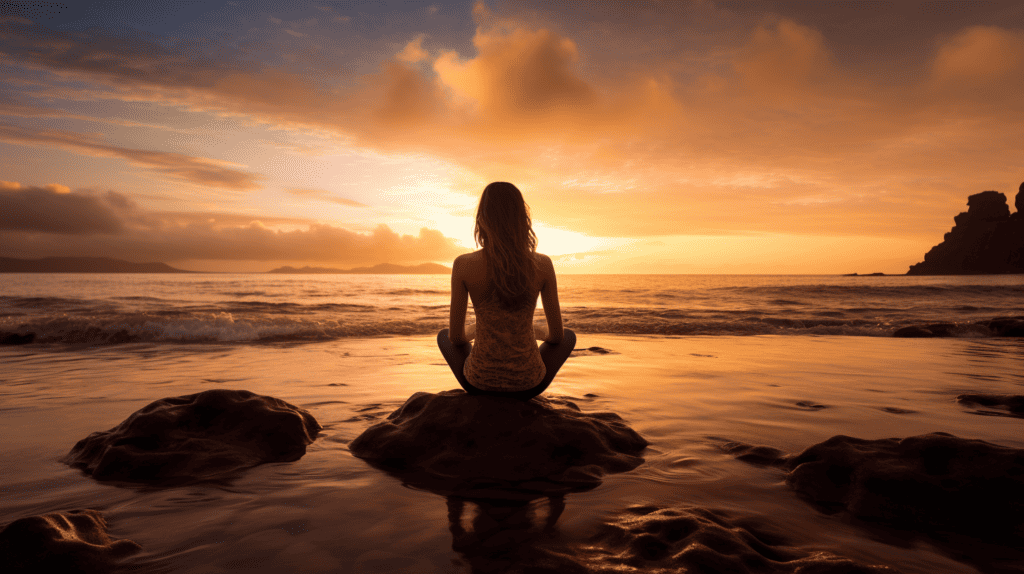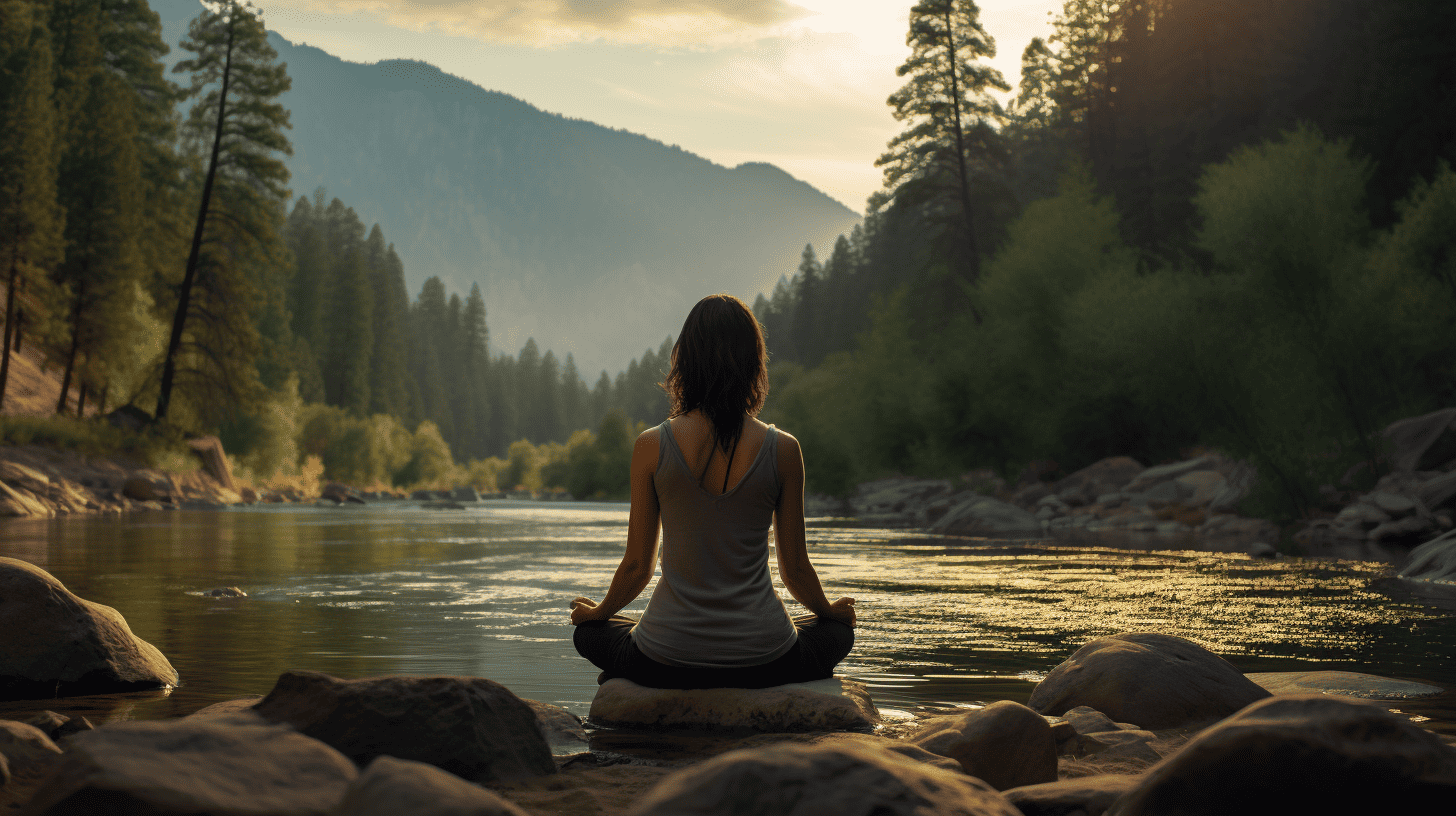Are you feeling overwhelmed by the chaos of everyday life and searching for inner peace? Look no further. I’ve been there, too, but through my journey, I’ve discovered the power of spiritual meditation.
With extensive research and personal experience, I’ve created an ultimate beginner’s guide to spiritual meditation. Let me show you step-by-step techniques that will transform your life. So, let’s dive in and embark on this incredible spiritual meditation journey together!
Key Takeaways
- Spiritual meditation is a way to find peace and connect with your higher self.
- Meditation has been practiced in various spiritual traditions for thousands of years.
- When meditating, it’s essential to sit on the floor with a straight back for better focus and energy flow.
- Choose to keep your eyes closed or slightly open during meditation based on personal comfort.
- Start with short meditation sessions and gradually increase the duration to build focus and stamina.
- Create a peaceful environment by finding a quiet space free from distractions in your home.
- Mindfulness breathing meditation involves focusing on the breath as an anchor to cultivate present-moment awareness.
- Observing the breath at specific points can help deepen your meditation practice.
Definition and purpose of spiritual meditation
Spiritual meditation is a way to find peace inside you. It helps connect with the more significant part of yourself. This is your higher self. Some call it awakening, others being mindful. The main reason for spiritual meditation is to feel calm and connect with this higher self.
I started feeling less anxious and happier after doing it daily for one month.
“Breathing is the single most important part of meditation, and you must learn to focus on your breath if you want to make the most of your practice.” Zenful Spirit
A brief history of meditation in various spiritual traditions
Meditation started a long time ago. It came from many spiritual groups all over the world. People in India used it as part of Hinduism and Buddhism over 5,000 years ago. In China, Taoists began to meditate around the same time.
Christians also use prayer as a form of meditation. Today, people from every culture use meditation to find peace inside themselves and connect with something bigger than themselves.
How to Meditate for Beginners
When beginning your meditation practice, it’s essential to find a comfortable position that allows for focus and concentration. Sitting on the floor with a straight back is recommended to align your body and maintain stability.
Avoid meditating in bed as it may lead to drowsiness or lack of discipline.
To enhance the quality of your meditation, make sure to have proper body posture. Sit cross-legged or on a cushion with the spine erect, allowing optimal energy flow and mental clarity.
Choose whether to keep your eyes closed or slightly open, depending on what feels most natural and comfortable.
As a beginner, start with short meditation sessions, gradually increasing the duration. This helps build focus and stamina while avoiding strain or frustration. Create a peaceful environment free from distractions by finding a quiet space in your home where you can relax without interruptions.
The recommended meditation position

Sitting on the floor is a great way to meditate. You need to keep your back straight (more on this below). This posture helps a lot when you want to focus. Doing this, you will feel more active and less sleepy than if you were in bed.
Your feet should cross each other, and your arms must rest on your thighs. Make sure your hands are cup-shaped over your knees. Keep your head level and face forward while doing it all! At first, try closing your eyes for better concentration levels during these meditation sessions that usually start from just 5 minutes long.
The significance of maintaining a straight back on the floor
A straight back helps your mind stay awake during meditation. Think of it like a tall tree. A tree stands strong and reaches high in the sky because its trunk is straight and firm.
The same goes for you while meditating.
Plus, it keeps your focus sharp, so you connect better with yourself.
Advising against meditation in bed for focus and discipline
Meditating in bed may not be the best idea if you want to stay focused and disciplined. It can make you feel sleepy, which could interfere with your meditation practice. Instead, it’s recommended to find a quiet and comfortable place to sit on the floor with a straight back.
This position helps maintain focus and enhances discipline during meditation sessions. So, avoid meditating in bed to get the most out of your practice.
Detailing the proper body position to enhance meditation quality

It’s recommended to sit with your feet crisscrossed, your back straight, and your head facing forward. Rest your arms gently on your thighs with your hands cupped together. This posture helps align your body and allows for better focus during meditation.
As for your eyes, you can either keep them closed or open during meditation. However, if you’re starting out as a beginner, it’s often advised to close your eyes as it can help eliminate distractions and promote better concentration.
Deciding between closed or open eyes to suit personal comfort
When deciding between closing or keeping your eyes open during meditation, it’s essential to consider what makes you feel most comfortable. Some people find that closing their eyes helps them better focus their attention inward and minimize distractions.
Closing your eyes can also promote relaxation and help create a more peaceful environment for meditation. On the other hand, some individuals may prefer to keep their eyes open, as it allows them to connect with the external world while still being mindful and present in the moment.
Ultimately, the choice between closed or open eyes is a personal preference that should be based on what feels suitable for you during your meditation practice.
Beginning with short meditation sessions and increasing duration over time
When starting your meditation practice, it is essential to begin with short meditation sessions and gradually increase the duration over time. This allows your mind and body to adjust to the practice and build endurance. Here are some tips to help you get started:
- Start with just 5 minutes: Set aside 5 minutes daily for your meditation practice. Find a quiet and comfortable space where you won’t be disturbed.
- Increase gradually: As you become more comfortable with the practice, slowly increase the duration of your sessions. You can add an extra minute every few days or every week, depending on what feels manageable for you.
- Listen to your body: How your body feels during the meditation sessions. If you start feeling restless or uncomfortable, it’s okay to take a break or shorten the session. It’s essential to listen to your body‘s needs.
- Be consistent: Consistency is key in establishing a meditation routine. Aim to meditate at the same time every day, whether in the morning, during your lunch break, or before bed. By making it a regular part of your routine, it becomes easier to stick with it.
- Set realistic goals: Avoid putting pressure on yourself to meditate for long periods from the beginning. Set realistic goals that work for you and allow yourself to progress gradually at a pace that feels comfortable.
Setting a peaceful environment to enhance meditation practice
To enhance your meditation practice, it is vital to create a peaceful environment. Here are some tips to help you set the right atmosphere:
- Find a quiet space: Look for a place in your home where you can meditate without disturbances. It could be a spare room, a designated corner, or even outdoors if that’s more soothing for you.
- Eliminate distractions: Turn off electronic devices or put them on silent mode. This will help you focus and prevent interruptions during your meditation session.
- Create a calming ambiance: Use soft lighting or candles to create a serene atmosphere. You can also play gentle music or nature sounds in the background to enhance relaxation.
- Make it comfortable: Sit on a cushion or mat that supports your posture and allows you to sit comfortably for an extended time. Avoid sitting on a chair or lying down, as it may make you feel too relaxed and hinder your focus.
- Set the right temperature: Ensure that the room is comfortable so that you’re not too hot or too cold during your meditation practice.
- Clear your space: Declutter the area where you’ll be meditating to create an organized and calming environment. A tidy space can help clear your mind and promote inner peace.
Practicing Mindfulness Breathing Meditation

In this section, we will delve into mindfulness breathing meditation. This technique involves focusing on the breath and using it as an anchor to cultivate present-moment awareness.
By observing the inhalation and exhalation, we can train our minds to stay grounded in the here and now.
To begin, find a quiet space where you won’t be disturbed for a few minutes. Get comfortable in a seated position, either on a cushion or chair, with your back straight. Take a deep breath and slowly exhale, allowing your body to relax.
As you settle into your meditation posture, bring your attention to your breath. Notice the sensation of the air entering through your nostrils, filling up your lungs, and then exiting again.
You might focus on one specific point of contact, such as the tip of your nose or the rise and fall of your abdomen.
It’s typical for thoughts or distractions to arise during meditation. When this happens, gently acknowledge them without judgment and let them go. Return.
Techniques for focusing on the breath and monitoring its rhythm
When practicing mindfulness breathing meditation, there are techniques you can use to focus on your breath and monitor its rhythm. These techniques can help you stay present in the moment and deepen your meditation practice. Here are some ways to do it:
- Find a quiet and comfortable place: Choose a peaceful environment where you won’t be easily distracted. Find a comfortable position, whether sitting on a chair or cushion, that allows you to relax and maintain an upright posture.
- Take a few deep breaths: Before starting meditation, take a few deep breaths to relax your body. Inhale deeply through your nose, feeling the air fill your lungs, and exhale slowly through your mouth, releasing any tension.
- Focus on your breath: Once you’re settled, bring your attention to your breath. Notice the sensation of the air entering and leaving your body. You can focus on the movement of your breath at the tip of your nostrils or on the rise and fall of your abdomen.
- Observe without judgment: As thoughts or distractions arise during meditation, gently acknowledge them without getting caught up. Instead of judging or analyzing these thoughts, observe them and let them go, returning your attention to your breath.
- Counting or labeling: Some people find it helpful to count their breaths as they inhale and exhale or label each breath as “in” and “out.” This can provide an anchor for concentration and assist in maintaining focus.
- Maintain a steady rhythm: Establish a natural rhythm with your breathing by allowing it to flow freely without forcing or controlling it. It may help to visualize yourself riding the gentle waves of each inhalation and exhalation.
Strategies for handling distractions and regaining concentration on the breath
During meditation, it’s normal to get distracted by thoughts and lose focus on the breath. When this happens, I gently bring my attention back to my breath. I don’t let myself get caught up in the distractions or react to them.
Instead, I stay present and refocus on the sensation of each inhale and exhale. This helps me regain concentration and brings me back into calmness and mindfulness.
I also remind myself not to move or react when physical sensations arise, like an itch or discomfort. Instead of giving in to these sensations, I focus on my breath and allow them to pass without judgment or attachment.
Maintaining equanimity in the face of physical sensations
Physical sensations, such as itches or discomfort, can arise during meditation. It is crucial not to react to these sensations and instead maintain a sense of calm and balance. When these sensations occur, gently bring your attention back to your breath and refocus on the present moment.
Remember that distractions are normal, and by practicing equanimity and staying centered, you can deepen your meditation practice and find inner peace.
The role of mindfulness in spiritual growth
Mindfulness plays a crucial role in spiritual growth. It involves bringing our attention to the present moment and observing our thoughts, emotions, and sensations without judgment.
By practicing mindfulness during meditation, we can cultivate a deeper connection with our higher self. It lets us let go of attachments to the past or worries about the future, bringing us inner peace.
Mindfulness helps us become more aware of ourselves and the world, leading to personal growth and a greater understanding of our spiritual essence. Through mindfulness, we can transform every aspect of our lives and embark on a profound spiritual journey towards enlightenment.
Establishing a Meditation Routine and Understanding Its Impact
Establishing a regular meditation routine is essential for spiritual growth and understanding the impact it can have on your life. By determining the ideal frequency of daily meditation, you can ensure consistent progress on your spiritual journey.
Regular practice allows you to experience the benefits of meditation, such as reduced stress, increased mindfulness, and a more profound sense of inner peace. Scientific studies also support the positive effects of meditation on overall well-being.
Consistency in your practice will lead to profound spiritual growth and transformation in every aspect of your life.
Determining the ideal frequency of daily meditation for spiritual progress
For spiritual progress, it is vital to find the right frequency of daily meditation. Starting with just 5 minutes is recommended for beginners. As you become more comfortable, gradually increase the duration to 10 or even 20 minutes.
Consistency is key – aim to meditate every day. Arnold Schwarzenegger, for example, meditates for 20 minutes in the morning and before bed. Remember, everyone’s experience and benefits may vary depending on the length of each session and how often you practice.
Find what works best for you on your spiritual journey.
Exploring the individual benefits and the critical nature of regular practice
Regular spiritual meditation offers many individual benefits that can profoundly impact our overall well-being. By dedicating time each day to this practice, we open ourselves up to experiencing a deep sense of inner peace and relaxation.
Meditation helps us reduce stress and negative emotions, improving mood and mental clarity. It also enhances our spiritual growth, allowing us to connect with our higher self and gain a deeper understanding of ourselves and the world around us.
Scientific studies have supported these benefits, showing that regular meditation can transform various aspects of our lives for the better. Therefore, making meditation a consistent part of our daily routine is essential in reaping these rewards.
Sharing anecdotal evidence and improvements observed after consistent meditation
I have personally experienced significant improvements in my well-being after consistently practicing meditation. One of the most noticeable changes has been an improvement in my mood and a reduction in negativity.
Before I started meditating regularly, I often found myself feeling stressed, anxious, and overwhelmed by negative thoughts. However, after just a month of daily meditation practice, I noticed a shift towards a more positive mindset.
I felt calmer, more at peace, and better equipped to handle the challenges that came my way. It was truly remarkable how something as simple as sitting quietly and focusing on my breath could have such a profound impact on my overall state of mind.
Scientific studies supporting the benefits of meditation
Scientific research has revealed numerous benefits of consistent meditation practice. These benefits have been validated in various studies conducted across different cultures and populations.
| Study | Findings |
|---|---|
| JAMA Internal Medicine, 2014 | Concluded that mindful meditation can help ease psychological stresses like anxiety, depression, and pain. |
| Frontiers in Human Neuroscience, 2012 | Found meditation to be associated with enhanced self-insight, morality, intuition, and fear modulation, all functions associated with the brain’s middle prefrontal lobe area. |
| Neuroscience and Biobehavioral Reviews, 2013 | Discovered meditation-related anxiety relief was associated with the activation of the anterior cingulate cortex and ventromedial prefrontal cortex, areas of the brain involved with executive-level function. |
| PLOS ONE, 2013 | Participants who meditated showed measurable changes in brain regions associated with memory, sense of self, empathy, and stress. |
| Harvard Medical School, 2011 | Reported the practice of mindful meditation may slow down the progression of Alzheimer’s and dementia. |
These findings only scratch the surface of the vast body of research supporting the benefits of meditation. As you embark on your spiritual journey, allow these scientific insights to bolster your confidence in the transformative power of sustained meditation.
Conclusion on The Beginners Guide To Spiritual Meditation
In conclusion, spiritual meditation is a powerful practice that can lead to inner peace and connection with your higher self. By following the step-by-step techniques outlined in this guide, beginners can learn how to meditate effectively and experience the benefits of mindfulness breathing meditation.
Remember to establish a regular meditation routine and create a peaceful environment for your practice. With dedication and consistency, you can integrate meditation into your daily life and embark on a transformative spiritual journey.
So why wait? Start your meditation practice today and discover the profound impact it can have on your overall well-being.
Recap of the meditation guidance for beginners
To recap, when starting your meditation practice as a beginner, it’s crucial to find a quiet and comfortable space in your home. Sit with crisscrossed feet and rest your hands on your thighs.
Close your eyes to help you focus and begin with short sessions of 5 minutes, gradually increasing the duration over time. Mindfulness breathing meditation is recommended, where you observe the rhythm of your breath while managing distractions and physical sensations.
Aim for daily meditation sessions of 10-20 minutes to experience the spiritual benefits. Remember that regular practice brings about positive changes in your overall well-being.
Encouragement for ongoing practice and exploration of spiritual meditation
I encourage you to continue practicing and exploring spiritual meditation. Remember, meditation is a journey that takes time and dedication. Don’t get discouraged if you don’t see immediate results.
Consistency is key in reaping the benefits of meditation.
By making meditation a regular part of your daily routine, you open yourself to a world of inner peace, self-discovery, and spiritual growth. Embrace the process and be patient with yourself as you develop your practice.
Take advantage of resources like guided meditation videos or classes to help deepen your understanding and enhance your experience. And don’t forget to share your progress and insights with others who are also on this path.
Final thoughts on integrating meditation into daily life for spiritual wellbeing
As I conclude this guide to spiritual meditation, I want to emphasize the importance of integrating meditation into your daily life for spiritual well-being. By making meditation a consistent practice, you can experience profound changes not only in your spiritual journey but also in every aspect of your life.
Regular meditation helps reduce stress, promote relaxation, and increase mindfulness. It lets you tap into your inner peace and connect with your higher self. So, find a quiet space in your home, get comfortable, take a deep breath, and start your meditation practice today.
Remember that even just a few minutes of daily meditation can have great benefits for your overall spiritual growth and transformation.
Q: What are the benefits of spiritual meditation?
A: Spiritual meditation offers numerous benefits, such as stress reduction, improved mental clarity, emotional balance, and a deep inner peace and connection with the higher self.
Q: How can I start meditation as a beginner?
A: As a beginner, you can start meditation by finding a quiet and comfortable space, focusing on your breath or a mantra, and gradually increasing the duration of your practice as you become more comfortable with it.
Q: What is the spiritual journey in the context of meditation?
A: The spiritual journey in meditation refers to the process of self-discovery, inner exploration, and personal growth that individuals experience as they delve deeper into their spiritual practice.
Q: What are some effective meditation techniques for spiritual practice?
A: Effective meditation techniques for spiritual practice include mindfulness meditation, visualization meditation, and techniques that focus on cultivating stillness and inner awareness.
Q: How can beginners start their spiritual meditation practice?
A: Beginners can start their spiritual meditation practice by seeking guidance from experienced practitioners, incorporating simple techniques into their daily routine, and staying open to the experience without pressure or judgment.
Q: What is the role of mindfulness in spiritual meditation?
A: Mindfulness plays a crucial role in spiritual meditation by encouraging individuals to stay present and aware of their thoughts, emotions, and surroundings without judgment, thus fostering a deeper sense of spiritual awareness and connection.
Q: Is there a comprehensive guide to meditation available for beginners?
A: Yes, there are numerous comprehensive guides to meditation for beginners that provide step-by-step instructions, practical tips, and insights into establishing a fulfilling and sustainable meditation practice.
Q: How can one effectively engage in spiritual meditation practice?
A: One can effectively engage in spiritual meditation by setting aside dedicated time to meditate, creating a tranquil environment, and approaching the practice with openness, receptivity, and a willingness to explore one’s spiritual dimensions.
Q: What role do thoughts and emotions play in spiritual meditation?
A: Thoughts and emotions are integral to spiritual meditation as they provide opportunities for self-reflection, personal growth, and the cultivation of compassion, understanding, and love towards oneself and others.
Q: Are there meditation videos available for practicing spiritual meditation?
A: Yes, there are numerous meditation videos available that cater to practicing spiritual meditation, offering guided sessions, visualizations, and inspirational content to support individuals in their spiritual journey.
###





Leave a Reply